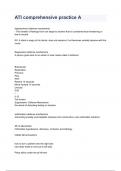College aantekeningen
Alle literatuur van Samenwerking in de Veiligheid
Cijfer: 8.0 Literatuur: Dupont, B. (2004). Security in the age of networks. Policing and Society, 14 (1), 76-91. Links to an external site. Loader, I. (2000). Plural policing and democratic governance. Social and Legal Studies, 9 (3), 323-345. Links to an external site. Bannink, D. and Tromm...
[Meer zien]





